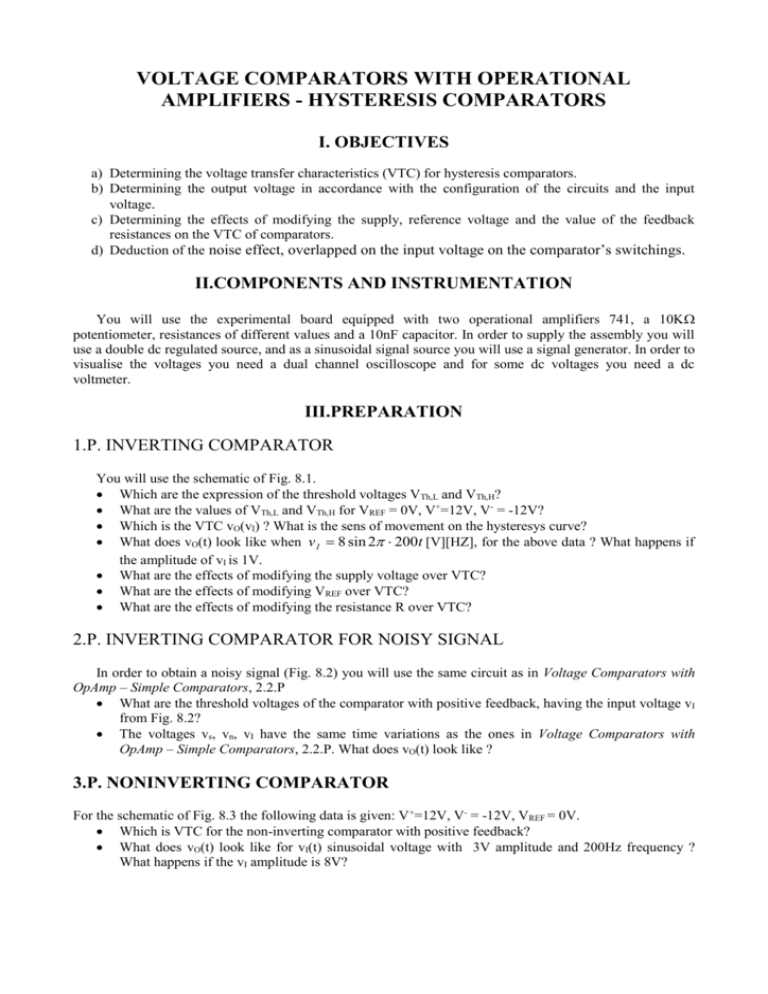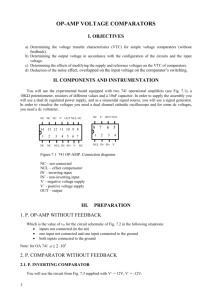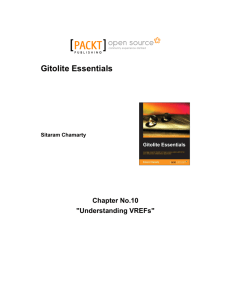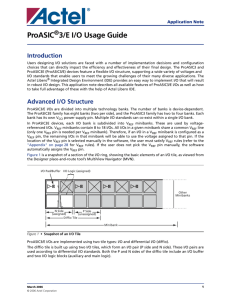L7 Voltage Comparator with Op-amp
advertisement

VOLTAGE COMPARATORS WITH OPERATIONAL AMPLIFIERS - HYSTERESIS COMPARATORS I. OBJECTIVES a) Determining the voltage transfer characteristics (VTC) for hysteresis comparators. b) Determining the output voltage in accordance with the configuration of the circuits and the input voltage. c) Determining the effects of modifying the supply, reference voltage and the value of the feedback resistances on the VTC of comparators. d) Deduction of the noise effect, overlapped on the input voltage on the comparator’s switchings. II.COMPONENTS AND INSTRUMENTATION You will use the experimental board equipped with two operational amplifiers 741, a 10K potentiometer, resistances of different values and a 10nF capacitor. In order to supply the assembly you will use a double dc regulated source, and as a sinusoidal signal source you will use a signal generator. In order to visualise the voltages you need a dual channel oscilloscope and for some dc voltages you need a dc voltmeter. III.PREPARATION 1.P. INVERTING COMPARATOR You will use the schematic of Fig. 8.1. Which are the expression of the threshold voltages VTh,L and VTh,H? What are the values of VTh,L and VTh,H for VREF = 0V, V+=12V, V- = -12V? Which is the VTC vO(vI) ? What is the sens of movement on the hysteresys curve? What does vO(t) look like when v I 8 sin 2 200t [V][HZ], for the above data ? What happens if the amplitude of vI is 1V. What are the effects of modifying the supply voltage over VTC? What are the effects of modifying VREF over VTC? What are the effects of modifying the resistance R over VTC? 2.P. INVERTING COMPARATOR FOR NOISY SIGNAL In order to obtain a noisy signal (Fig. 8.2) you will use the same circuit as in Voltage Comparators with OpAmp – Simple Comparators, 2.2.P What are the threshold voltages of the comparator with positive feedback, having the input voltage vI from Fig. 8.2? The voltages vs, vn, vI have the same time variations as the ones in Voltage Comparators with OpAmp – Simple Comparators, 2.2.P. What does vO(t) look like ? 3.P. NONINVERTING COMPARATOR For the schematic of Fig. 8.3 the following data is given: V+=12V, V- = -12V, VREF = 0V. Which is VTC for the non-inverting comparator with positive feedback? What does vO(t) look like for vI(t) sinusoidal voltage with 3V amplitude and 200Hz frequency ? What happens if the vI amplitude is 8V? 1. INVERTING COMPARATOR Exploration You will use the experimental schematic from Fig. 8.1 V+ = +12V, V- = -12V from the dual dc regulated power supply. You will measure VREF with a dc voltmeter and you will adjust VREF = 0V, with P. vI =8sin2 π ·200t[V][Hz] from the signal generator. Using the oscilloscope, Y-t mode, visualize vI(t) and vO(t). Using the oscilloscope, Y-X mode visualize VTC vO(vI), applying the voltages vI and vO on the X and Y inputs of the oscilloscope . Modify the amplitude of vI to 1V. Using the oscilloscope, Y-t mode, visualize vI(t) and vO(t). V+ P 10K VREF R + R 10K 5K1 vO vI V- Fig. 8.1 Inverting comparator with positive feedback A. The effects of modifying the voltage supply You will modify the supply voltages V+= +9V, V- = -9V. Using the oscilloscope visualize vI(t), vO(t), then VTC vO(vI) for VREF= 0V and vI amplitude of 8V. You will modify the supply voltages to V+= +15V, V- = -9V. Visualize vI(t), vO(t) and VTC. B. The effects of modifying VREF Supply the assembly with V+=+12V, V-= -12V. Adjust P until VREF =3V. Using the oscilloscope, visualize vI(t), vO(t) and vO(vI). Set VREF = -3V. Using the oscilloscope visualize vI(t), vO(t) and vO(vI). Results vI(t) and vO(t) for a vI amplitude of 8V and 1V. VTC vO(vI) when the amplitude of vI is 8V. What are the values of the threshold voltages VTh,H and VTh,L? What is the width of the hysteresys curve ΔVTh=VTh,H-VTh,L? A. The effects of modifying the voltage supply vI(t), vO(t),vO(vI) for V+= +9V, V- = -9V, and for V+= +15V, V- = -9V. What are the effects of modifying the supply voltages on the threshold voltages? Is the width of the hysteresys curve affected by the modification of the supply voltage? Why? What is the relation between VOH and V+? And between VOL and V- ? B. The effects of modifying VREF vI(t), vO(t), vO(vI) for VREF = 4V and for VREF = -4V and for V+= +15V, V-= -9V. What are the values of the threshold voltages VTh,H and VTh,L? Are they related to VREF? Is the width of the hysteresys curve modified for VREF = 0V? Modifying VREF, the hysteresys curve will move along one of the axis. Which one? 2 2. INVERTING COMPARATOR FOR NOISY SIGNAL You will use the circuit shown in Fig. 8.2. V+ 10K V+ R4 2K2 R5 R3 220nF Vn 10K R2 C R 10K R+ 1K8 5K1 vO vI VR1 5K1 vs V- Fig. 8.2 Inverting comparator with positive feedback and noisy signal Exploration Supply the assembly with V+= +12V, V- = -12V. You will use the oscilloscope as in Voltage Comparators with OpAmp – Simple Comparators. Using the oscilloscope you will visualize vI and vO at the same time. Results vI(t),vO(t). Compare the shape of the waveform of vO with the one from 1. In what way is the output voltage influenced by the existence of the noise overlapped on the source voltage? Compare the shape of the waveform of vO with the one from Voltage Comparators with OpAmp – Simple Comparators, 2.2.paragraph. How do you explain that introducing the positive feedback you eliminate the undesirable switching (that appears because of the noise)? 3. NONINVERTING COMPARATOR You will use the circuit shown in Fig. 8.3 V+ R R vI + 10K 5K1 VREF=0 vO Fig 8.3 Noninverting comparator with positive feedback VExploration Supply the assembly with the differential voltage: V+=12V, V- = -12V. VREF=0, by connecting the inverting input to the ground. vI is a sinusoidal voltage with 8V amplitude and 200Hz frequency from the signal generator. Using the calibrated oscilloscope, you will see vI(t), vO(t) and VTSC vO(vI). Results vI(t), vO(t). VTC Compare the VTC with the one obtained for the inverting comparator with positive feedback, for the same values of the supply and reference voltages, from the point of view of the output voltage values, the threshold voltages, and the sens of movement on the hysteresys curve. Why is this comparator called” noninverting”? 3










